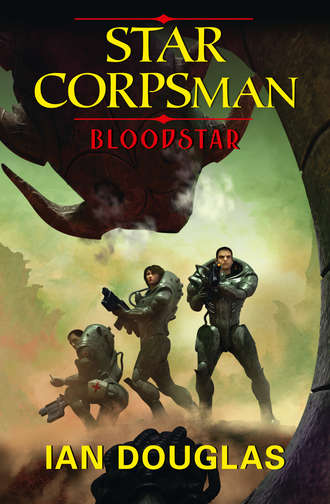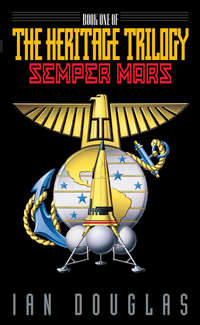
Полная версия
Bloodstar
“Doc,” Colby said, “that feels weird as hell.”
“Be glad I doped you up,” I told him. “If I had to set your leg without the anodyne, you’d be calling me all sorts of nasty things right now.”
I locked the nano sleeve down, holding the break rigid. I sent some loose nanobots through the surrounding tissue, turning it ghostly visible on the screen just to double-check. There was a little low-level internal bleeding—Colby would have a hell of a bruise on his shin later—but nothing serious. I diverted some anodynes to the tibial and common fibular nerves at the level of his knee with a backup at the lumbosacral plexus, shutting down the pain receptors only.
“Right,” I told him. “Let me know if this hurts.” Gingerly, I switched off the receptor blocks in his brain.
“Okay?”
“Yeah,” he said. “It just got … sore, a little. Not too bad.”
“I put a pain block at your knee, but your brain is functioning again. At least as well as it did before I doped you.”
“You’re a real comedian, Doc.”
I told his armor to lock down around his calf and shin, providing an external splint to back up the one inside. I wished I could check the field medicine database, but the chance of the enemy picking up the transmission was too great. I just had to hope I’d remembered everything important, and let the rest slide until we could get Colby back to sick bay.
“Okay, Gunny,” I said. “He’s good to go.”
I know it seemed callous, but a tibia greenstick is no big deal. If it had been his femur, now, the big bone running from hip to knee, I might have had to call for an immediate medevac. The muscles pulling the two ends of the femur together are so strong that the nano I had on hand might not have been enough. I would have had to completely immobilize the whole leg and keep him off of it, or risk doing some really serious damage if things let go.
The truth of the matter is that they pay us corpsmen for two jobs, really. We’re here to take care of our Marines, the equivalent of medics in the Army, but in the field our first priority is the mission. They hammer that into us in training from day one: provide emergency medical aid to the Marines so that they can complete their mission.
“How about it, Colby. Can you get up?”
The Marine stood—with an assist from Lewis and the Gunny. “Feels pretty good,” he said, stamping the foot experimentally.
“Don’t do that,” I told him. “We’ll still need to get you to sick bay, where they can do a proper osteofuse.”
“Good job, Doc,” Gunny told me. “Now pack up your shit and let’s hump it.”
I closed up my M-7 and dropped both the hypo and the sterile plastic shell it had come in into a receptacle on my thigh. They’d drilled it into us in FMF training: never leave anything behind that will give the enemy a clue that you’ve been there.
While I’d been working on Colby, the rest of the recon squad had joined up about a kilometer to the north and started marching. Gunny, Lewis, Colby, and I were playing catch-up now, moving across that cold and rock-strewn desert at double-time.
According to our tacsit displays, we were 362 kilometers and a bit directly south of our objective, a collection of pressurized Mars huts called Schiaparelli Base. If we hiked it on foot, it would take us the better part of ten days to make it all the way.
Not good. Our combat armor could manufacture a lot of our logistical needs from our surroundings, at least to a certain extent. It’s called living off the air, but certain elements—hydrogen and oxygen, especially—are in very short supply on Mars. Oxygen runs to about 0.13 percent in that near-vacuum excuse for an atmosphere, and free molecular hydrogen is worse—about fifteen parts per billion. You can actually get more by breaking down the hints of formaldehyde and methane released by the Martian subsurface biota, but it’s still too little to live on. The extractors and assemblers in your combat armor have to run for days just to get you one drink of water. The units recycle wastes, of course; with trace additives, a Marine can live on shit and piss if he has to, but the process yields diminishing returns and you can’t keep it up for more than a few days.
So Lewis and I doubled up with Colby. There was a risk of him coming down hard and screwing the leg repairs, but with me on his right arm and Lewis on his left, we could reduce the stress of landing on each bound. We taclinked our armor so that the jets would fire in perfect unison, and put ourselves into a long, flat trajectory skimming across the desert. Gunny paced us, keeping a 360-eye out for the enemy, but we still seemed to have the desert to ourselves.
And four hours later we reached the Calydon Fossa, a straight-line ditch eroded through the desert, half a kilometer deep and six wide. It took another hour to get across that—the canyon was too wide for us to jet-jump it, and the chasma slopes were loose and crumbling. But we slogged down and we slogged up and eight kilometers more brought us to the Ius Chasma.
It’s not the deepest or the most spectacular of the interlaced canyons making up the Valles Marineris, but it’ll do: Five and a half kilometers deep and almost sixty kilometers across at that point, it’s deep enough to take in Earth’s Grand Canyon as a minor tributary. The whole Valles Marineris is almost as long as the continental United States is wide back home—two hundred kilometers wide and ten kilometers deep at its deepest—where the Grand Canyon runs a paltry 1,600 meters deep.
The view from the south rim was spectacular.
But we weren’t there for sightseeing. We rendezvoused with First Squad and made the final approach to Schiaparelli Base. I stayed back with Colby while the others made the assault, but everything went down smooth as hyperlube. The whole sequence would have been a lot more exciting if this had been a real op, but the bad guys were U.S. Aerospace Force security troops, and Ocher Sands is the annual service-wide training exercise designed to work out the bugs and accustom our combat troops to operating in hostile environments against a high-tech enemy.
I can’t speak for the USAF bluesuits, but we had a good day. Despite Colby’s injury and a bad case of the scatters coming down—someone was going to get chewed a new one for that little SNAFU—all eight squads pulled it together, deployed without being spotted, and took down their assigned objectives, on sched and by the download. An hour later we had a Hog vectoring in for medevac.
I rode back up to orbit with Colby.
And it was just about then that the fecal matter intercepted the rotational arc of the high-speed turbine blades.
Chapter Two
FOR A CENTURY NOW WE HUMANS HAVE BEEN LURKERS ON THE GALACTIC Internet, listening and learning but not saying a word. We’re terrified, you see, that they might find us.
The EG-Net, as near as we can tell, embraces a fair portion of the entire Galaxy, a flat, hundred-thousand-light-year spiral made of four hundred billion suns and an estimated couple of trillion planets. The Net uses modulated gamma-ray lasers, which means, thanks to the snail’s-pace crawl of light, that all of the news is out of date to one degree or another by the time we get it. Fortunately, most of what’s on there doesn’t have an expiration date. The Starlord Empire has been collapsing for the past twenty thousand years, and the chances are good that it’ll still be collapsing twenty thousand years from now.
The Galaxy is a big place. Events big enough to tear it apart take a long time to unfold.
The closest EG transmission beam to Sol passes through the EG Relay at Sirius, where we discovered it during our first expedition to that system 128 years ago. The Sirius Orbital Complex was constructed just to eavesdrop on the Galactics—there’s nothing else worthwhile in the system—and most of what we know about Deep Galactic history comes from there. We call it the EG, the Encyclopedia Galactica, because it appears to be a data repository. Nested within the transmission beams crisscrossing the Galaxy like the web of a drunken spider are data describing hundreds of millions of cultures across at least six billion years, since long before Sol was born or the Earth was even a gleam in an interstellar nebula’s eye. It took us twenty years just to crack the outer codes to learn how to read what we were seeing. And what we’ve learned since represents, we think, something less than 0.01 percent of all of the information available.
But even that microscopic drop within the cosmic ocean is enough to prove just how tiny, how utterly insignificant, we humans are in the cosmic scheme of things.
The revelation shook humankind to its metaphorical core, an earthquake bigger than Copernicus and Galileo, deeper than Darwin, more far-reaching than Hubbell, more astonishing than Randall, Sundrum, and Witten.
And the revelation damn near destroyed us.
“HEY, E-CAR!” HM3 MICHAEL C. DUBOIS HELD UP A LAB FLASK AND swirled the pale orange liquid within. “Wanna hit?”
I was just finishing a cup of coffee as I wandered into the squad bay, and still had my mug in hand. I sucked down the dregs and raised the empty cup. “What the hell are you pedaling this time, Doob?” I asked him.
“Nothing but the best for the Black Wizard heroes!”
“Paint stripper,” Corporal Calli Lewis told me, and she made a bitter face. I noticed that she took another swig from her mug, however, before adding, “The bastard’s trying to poison us.”
Doobie Dubois laughed. “Uh-uh. It’s methanol that’ll kill you … or maybe make you blind, paralyzed, or impotent. Wood alcohol, CH3OH. This here is guaranteed gen-u-wine ethanol, C2H5OH, straight out of the lab assemblers and mixed with orange juice I shagged from a buddy in the galley. It’ll put hair on your chest.”
“Not necessarily a good thing, at least where Calli’s concerned,” I said as he poured me half a mug.
“Yeah?” he said, and gave Calli a wink. “How do you know? Might be an improvement!”
“Fuck you, squid,” she replied.
“Any time you want, jarhead.”
I took a sip of the stuff and winced. “Good galloping gods, that’s awful!”
“Doc can’t hold his ’shine,” Sergeant Tomacek said, and the others laughed. A half dozen Marines were hanging out in the squad bay, and it looked like Doob had shared his talent for applied nanufactory chemistry with all of them. Highly contra-regs, of course. The Clymer, like all U.S. starships, is strictly dry. I suspected that Captain Reichert knew but chose not to know officially, so long as we kept the party to a dull roar and no one showed up drunk on duty.
The viewall was set to show an optical feed from outside, a deck-to-overhead window looking out over Mars, 9,300 kilometers below. The planet showed a vast red-orange disk with darker mottling; I could see the pimples of the Tharsis bulge volcanoes easily, with the east-to-west slash of the Valles Marineris just to the east. Phobos hung in the lower-right foreground, a lumpy and dark-gray potato, vaguely spherical but pocked and pitted with celestial acne. The big crater on one end—Stickney—and the Mars Orbital Research Station, rising from the crater floor, were hidden behind the moonlet’s mass, on the side facing the planet. The image, I decided, was being relayed from the non-rotating portion of the George Clymer. The Clymer’s habitation module was a fifty-meter rotating ring amidships, spinning six and a half times per minute to provide a modest four tenths of a gravity, the same as we’d experienced down on Mars.
“So what’s the celebration?” I asked Dubois. He always had a reason for breaking out the lab-nanufactured drinkables.
“The end of FMF training, of course! What’d you think?”
I took another cautious sip. It actually wasn’t too bad. Maybe that first swig had killed off the nerve endings.
“You’re one-eighty off course, Doob,” I told him. “We still have Europa, remember?”
FMF—the Fleet Marine Force—was arguably the most coveted billet in the entire U.S. Navy Hospital Corps. To win that silver insignia for your collar, you needed to go through three months of Marine training at Lejeune or Pendleton, then serve with the Marines for one year, pass their physical, demonstrate a daunting list of Marine combat and navigation skills, and pass a battery of tests, both written and in front of a senior enlisted board.
I’d been in FMF training since I’d made Third Class a year ago; our assignment on board the Clymer was the final phase of our training, culminating in the Ocher Sands fun and games that had us performing a live insertion and taking part in a Marine planetary assault. After this, we were supposed to deploy to Europa for three weeks of practical xenosophontology, swimming with the Medusae. After that, those of us still with the program would take our boards, and if we were lucky, only then would we get to append the letters FMF after our name and rank.
“Not the way I heard it, e-Car,” he said. He took a swig of his product straight from the flask. “Scuttlebutt has it we’re deploying I-S.”
I ignored use of the disliked handle. My name, Elliot Carlyle, had somehow been twisted into “e-Car.” Apparently there was a law of the Corps that said everyone had to have a nickname. Doob. Lewis was “Louie.” I’d spent the past year trying to get myself accepted as “Hawkeye,” a nod both to James Fenimore Cooper and to a twentieth-century entertainment series about military medical personnel in the field from which I’d downloaded a few low-res 2-D episodes years ago.
“Interstellar?” I said. “You’re full of shit. This stuff’s rotting your gray cells.”
“Don’t be so sure about your diagnosis, Doc,” Lewis told me. “I heard the same thing from a buddy in Personnel.”
“You’re both full of it,” I said. “Why would they send us?”
“Our dashing good looks and high intelligence?”
“In your case, Doob, it probably has to do with a punishment detail. You on the Old Man’s shit list?”
“Not so far as I know.”
“So what’s supposed to be going down?”
Dubois grew serious, which was damned unusual for him. “The Qesh,” he said.
Download
Encyclopedia Galactica/Xenospecies Profile
Entry: Sentient Galactic Species 23931
“Qesh”
Qesh, Qesh’a, Imperial Qesh, Los Imperiales, “Jackers,” “Imps”
Civilization Type: 1.165 G
TL 20: FTL, Genetic Prostheses, Quantum Taps, Relativistic Kinetic Conversion
Societal Code: JKRS
Dominant: clan/hunter/warrior/survival
Cultural library: 5.45 x 1016 bits
Data Storage/Transmission DS/T: 2.91 x 1011s
Biological Code: 786.985.965
Genome: 4.2 x 109 bits; Coding/non-coding: 0.019.
Biology: C, N, O, S, S8, Ca, Cu, Se, H2O, PO4
TNA
Diferrous hemerythrin proteins in C17H29COOH circulatory fluid.
Mobile heterotrophs, carnivores, O2 respiration.
Septopedal, quad- or sextopedal locomotion.
Mildly gregarious, polygeneric [2 genera, 5 species]; trisexual.
Communication: modulated sound at 5 to 2000 Hz and changing color patterns.
Neural connection equivalence NCE = 1.2 x 1014
T = ~300o to 470o K; M = 4.3 x 105 g; L: ~5.5 x 109s
Vision: ~5 micrometers to 520 nanometers, Hearing: 2 to 6000 Hz
Member: Galactic Polylogue
Receipt galactic nested code: 1.61 x 1012 s ago
Member: R’agch’lgh Collective
Locally initiated contact 1.58 x 1012 s ago
Star F1V; Planet: Sixth
a = 2.4 x 1011m; M = 2.9 x 1019g; R = 2.1 x 107m; p = 2.7 x 106s
Pd = 3.2 x 107s, G = 25.81 m/s2
Atm: O2 26.4, N2 69.2, CO2 2.5, CO 2.1, SO2 0.7, at 2.5 x 105 Pa
Librarian’s note: First direct human contact occurred in 2188 C.E. at Gamma Ophiuchi. Primary culture now appears to be nomadic predarian, and is extremely dangerous. Threat level = 1.
We’d all downloaded the data on the Qesh, of course, as part of our Marine training. Know your enemy and all of that. Humans had first run into them fifty-nine years ago, when the Zeng He, a Chinese exploration vessel, encountered them while investigating a star system ninety-some light years from Sol. The Zeng He’s AI managed to get off a microburst transmission an instant before the ship was reduced to its component atoms. The signal was picked up a few years later by a Commonwealth vessel in the area and taken back to Earth, where it was studied by the Encyclopedian Library at the Mare Crisium facility on the moon. The Zeng He’s microburst had contained enough data to let us find the Qesh in the ocean of information within the Encylopedia Galactica and learn a bit about them.
We knew they were part of the R’agch’lgh Collective, the Galactic Empire, as the news media insisted on calling it. We knew they were from a high-gravity world, that they were big, fast, and mean.
And with the ongoing collapse of the Collective, we knew they’d become predarians.
The net media had come up with that word, a blending of the words predators and barbarians. That was unfortunate, since in our culture barbarian implies a relatively low technology; you expect them to be wearing shaggy skins, horned helmets, and carrying whopping big swords in their primary manipulators, looking for someone to pillage.
As near as we could tell, they were predators, both genetically and by psychological inclination. Their societal code, JKRS—which is where “Jackers,” one of their popular nicknames, had come from—suggested that their dominant culture was organized along clan/family lines, that they’d evolved from carnivorous hunters, that they considered themselves to be warriors and possessed what might be called a warrior ethos, and, perhaps the most chilling, that they possessed an essentially Darwinian worldview—survival of the fittest, the strong deserve to live. The fact that their technological level allowed them to accelerate asteroid-sized rocks to near-c and slam them into a planet was a complementary extra.
These guys had planet-killers.
The Crisium librarians thought—guessed would be the more accurate term—that the Qesh constituted some sort of military elite within the R’agch’lgh Collective, a kind of palace guard or special assault unit used to take out worlds or entire species that the Collective found to be obstreperous or inconvenient. But with the fall of the Collective, the Qesh were thought to have gone freelance, wandering the Galaxy in large war fleets taking what they wanted and generally trying to prove that they were the best, the strongest, the fittest—something like a really sadistic playground bully without adult supervision.
That change of status must have been fairly recent—within the last couple of thousand years or so. According to the EG, they were still working for the Collective.
And for all we knew maybe some of them were, way off, deep in toward the Galactic Core, where the R’agch’lgh might still be calling the shots. Our local branch of the EG Library hadn’t been updated for five thousand years, however, and evidently a lot had happened in the meantime.
The Galaxy was going through a period of cataclysmic change, but from our limited perspective, it was all taking place in super-slow motion.
“What,” I said. “The Qesh are coming here?”
“My friend in Personnel,” Lewis said, “told me there’d been a call for help from one of our colonies. The colony is supposed to be pre-Protocol, so …” She shrugged. “Send in the Marines.”
It made sense, in a horrific kind of way. Commonwealth Contact Protocol had been developed in 2194, and it laid out very strict rules and regs governing contact with new species. Partially, that was to protect the new species, of course. Human history has a long and bloody tradition of one culture stumbling into a new and eradicating it, through disease, through greed, through conquest, through sheer, bloody-minded stupidity.
But even more it was to protect us. We were just at the very beginning of our explorations into the Galaxy, and there were Things out there we didn’t understand and which didn’t understand us—or they didn’t care, or they simply saw us as a convenient source of raw materials. Over the course of the past fifty years, we’d taken special steps to screen our civilization’s background noise, and the AI navigators in our starships were designed to purge all data that might give a clue to the existence and location of Earth or Earth’s colonies if they encountered an alien ship or world.
A Qesh relativistic impactor, it was believed, could turn Earth’s entire crust molten. We did not want to have them or their Imperial buddies showing up on our doorstep in a bad mood.
The problem was, the barn door had been open for a bunch of years, and the horses had long since gotten loose. Radio and television signals were expanding into interstellar space at the rate of one light year per year, in a bubble now something like six hundred light years across. Technology researchers liked to insist that the useful information/noise ratio drops off to damned near zero only a couple of light years out; anyone out there listening for a juicy young prespaceflight civilization probably wouldn’t be able to pick our twentieth-century transmissions out of the interstellar white noise—but the kicker was the word probably. We just don’t know what’s possible; the EG mentions galactic civilizations out there that are on the order of 5 × 1016 seconds old—that’s longer than Earth has been around as a planet. I don’t think it’s possible for us to say what such a civilization could or could not do.
But things get uglier when it comes to our pre-Protocol colonies. There are a lot of them out there, scattered across the sky from Sagittarius to Orion. The earliest was Chiron, of course, at Alpha Centauri A IV, founded in 2109. They’re all close enough to Earth to have signed the Protocol shortly after it was written, but there are plenty of colonies out there that for one reason or another have nothing to do with Earth or the Commonwealth. Many of them we don’t even have listed, and if we don’t know they exist, we can’t police them.
But if they were established before the year 2194, they probably still have navigational coordinates for Earth somewhere in their computer network. And someone with the technology to figure out how our computers work, sooner or later, would break the code and they might come hunting for us.
Our only recourse in that case was to go looking for them. If we could contact them and get them to agree to abide by the Protocol, great.
But if they didn’t … well, as Lewis had so eloquently put it, Send in the Marines.
“Now hear this, now hear this,” a voice said from the squad bay’s intercom speaker. “All hands prepare for one gravity acceleration in ten minutes, repeat, ten minutes. Secure all loose gear and reconfigure hab module spaces. That is all.”
“That was fast,” Dubois said.
“Yeah, but where the hell are we going?” I wanted to know. I looked at Lewis. “Your friend have any word on that?”
“Actually,” she said, “from what he said, hell is a pretty good description.”
In fact, though, our destination turned out to be Earth.
Most of the hab space on board an attack transport like the Clymer is dedicated to living space. She carries 1,300 Marines besides her normal complement of 210 officers and crew, and all of that humanity is packed into the rotating ring around her central spine, along with the galleys and mess halls, sick bay, lab spaces, rec and VR bays, life-support nanufactories, and gear lockers.









